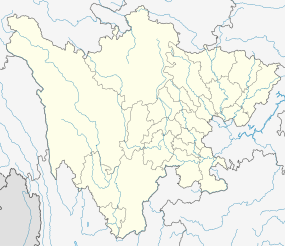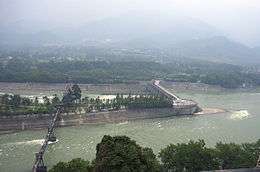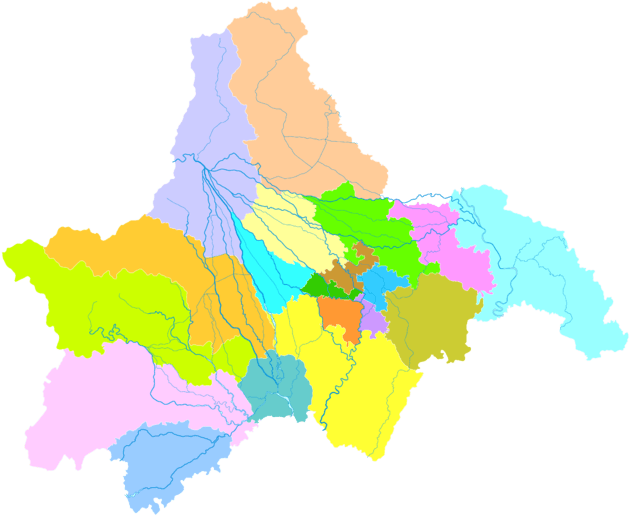Dujiangyan City
| Dujiangyan 都江堰市 | ||||||||||||||||||||||||||||||||||||||||||||||||||||||||||||
|---|---|---|---|---|---|---|---|---|---|---|---|---|---|---|---|---|---|---|---|---|---|---|---|---|---|---|---|---|---|---|---|---|---|---|---|---|---|---|---|---|---|---|---|---|---|---|---|---|---|---|---|---|---|---|---|---|---|---|---|---|
| County-level city | ||||||||||||||||||||||||||||||||||||||||||||||||||||||||||||
|
| ||||||||||||||||||||||||||||||||||||||||||||||||||||||||||||
 Dujiangyan Location in Sichuan | ||||||||||||||||||||||||||||||||||||||||||||||||||||||||||||
| Coordinates: 31°00′04″N 103°37′05″E / 31.001°N 103.618°ECoordinates: 31°00′04″N 103°37′05″E / 31.001°N 103.618°E[1] | ||||||||||||||||||||||||||||||||||||||||||||||||||||||||||||
| Country | People's Republic of China | |||||||||||||||||||||||||||||||||||||||||||||||||||||||||||
| Province | Sichuan | |||||||||||||||||||||||||||||||||||||||||||||||||||||||||||
| Sub-provincial city | Chengdu | |||||||||||||||||||||||||||||||||||||||||||||||||||||||||||
| Municipal seat | Guankou (灌口街道) | |||||||||||||||||||||||||||||||||||||||||||||||||||||||||||
| Area | ||||||||||||||||||||||||||||||||||||||||||||||||||||||||||||
| • Total | 1,208 km2 (466 sq mi) | |||||||||||||||||||||||||||||||||||||||||||||||||||||||||||
| Population (2010)[2] | ||||||||||||||||||||||||||||||||||||||||||||||||||||||||||||
| • Total | 657,996 | |||||||||||||||||||||||||||||||||||||||||||||||||||||||||||
| • Density | 545/km2 (1,410/sq mi) | |||||||||||||||||||||||||||||||||||||||||||||||||||||||||||
| Time zone | China Standard (UTC+8) | |||||||||||||||||||||||||||||||||||||||||||||||||||||||||||
| Postal code | 6118XX | |||||||||||||||||||||||||||||||||||||||||||||||||||||||||||
| Chengdu district map |
| |||||||||||||||||||||||||||||||||||||||||||||||||||||||||||
| Website |
www | |||||||||||||||||||||||||||||||||||||||||||||||||||||||||||
| Dujiangyan | |||||||||
| Chinese | 都江堰 | ||||||||
|---|---|---|---|---|---|---|---|---|---|
| Postal |
Tukiangyen Kwanhsien (until 1988) | ||||||||
| |||||||||
| Guanxian | |||||||||
| Traditional Chinese | 灌縣 | ||||||||
|---|---|---|---|---|---|---|---|---|---|
| Simplified Chinese | 灌县 | ||||||||
| Postal | Kwanhsien | ||||||||
| |||||||||
Dujiangyan (Chinese: 都江堰; pinyin: Dūjiāngyàn) is a county-level city under the jurisdiction of Chengdu, the capital of Sichuan province, People's Republic of China, bordered by the Ngawa Tibetan and Qiang Autonomous Prefecture to the north and west. It has an area of 1,208 km2 (466 sq mi) and a population of 600,000 in 2003.[3]
Dujiangyan was formerly a county named Guanxian (灌县; Guan County), in Chinese literally "irrigation" (guan) county (xian). The county became a county-level city in 1988, and was renamed after the Dujiangyan Irrigation System, which is located in the northwestern area of the city, famous for still providing neighboring major city Chengdu with water even though it was built around 250 BC.
History
Around 250 BC during the Warring States period, Li Bing, a governor of Shu (present Sichuan Province) in the Qin state with his son directed the construction of Dujiangyan. Li Bing gave up the old way of dam building, which was simply trying to catch the floodwaters. Instead he employed a new method by channeling and dividing the water to harness the Min River. He accomplished this by separating the project into two main parts: the headwork and the irrigation system. The project effectively put flood waters under control. For over two thousand years the whole system has functioned perfectly, serving not only for flood prevention but also as an immense source for irrigation and a means to facilitate shipping and wood drifting. It has contributed greatly to the richness of Chengdu Plain with its reputation as "The Land of Abundance".
On 12 May 2008, the city was the closest to the epicenter of the 2008 Sichuan earthquake and the city suffered severe damage. Xinjian Primary School, Juyuan Middle School, and Xiang'e Middle School collapsed in the earthquake; Beijie Primary School did not collapse.[4][5][6]
Administrative divisions
Dujiangyan has 17 towns and 2 townships:
- Towns:
- Guankou (灌口镇)
- Xingfu (幸福镇)
- Puyang (蒲阳镇)
- Juyuan (聚源镇)
- Chongyi (崇义镇)
- Tianma (天马镇)
- Shiyang (石羊镇)
- Liujie (柳街镇)
- Yutang (玉堂镇)
- Zhongxing (中兴镇)
- Qingchengshan (青城山镇)
- Longchi (龙池镇)
- Xujia (胥家镇)
- Anlong (安龙镇)
- Daguan (大观镇)
- Zipingpu (紫坪铺镇)
- Cuiyuehu (翠月湖镇)
- Townships:
- Xiang'e (向峨乡)
- Hongkou (虹口乡)
Transport
Climate
| Climate data for Dujiangyan (1971−2000) | |||||||||||||
|---|---|---|---|---|---|---|---|---|---|---|---|---|---|
| Month | Jan | Feb | Mar | Apr | May | Jun | Jul | Aug | Sep | Oct | Nov | Dec | Year |
| Average high °C (°F) | 8.2 (46.8) |
9.8 (49.6) |
14.0 (57.2) |
19.9 (67.8) |
24.2 (75.6) |
26.4 (79.5) |
28.3 (82.9) |
28.4 (83.1) |
23.9 (75) |
19.1 (66.4) |
14.5 (58.1) |
9.8 (49.6) |
18.9 (66.0) |
| Average low °C (°F) | 2.3 (36.1) |
4.0 (39.2) |
7.3 (45.1) |
11.9 (53.4) |
16.5 (61.7) |
19.6 (67.3) |
21.2 (70.2) |
21.2 (70.2) |
17.8 (64) |
13.6 (56.5) |
8.8 (47.8) |
3.8 (38.8) |
12.3 (54.2) |
| Average precipitation mm (inches) | 16.4 (0.646) |
23.1 (0.909) |
41.0 (1.614) |
66.2 (2.606) |
99.9 (3.933) |
136.4 (5.37) |
257.6 (10.142) |
254.5 (10.02) |
178.1 (7.012) |
67.1 (2.642) |
33.2 (1.307) |
11.9 (0.469) |
1,185.4 (46.67) |
| Average precipitation days (≥ 0.1 mm) | 10.4 | 13.1 | 15.3 | 16.2 | 17.5 | 17.2 | 18.7 | 17.2 | 20.3 | 18.5 | 12.4 | 8.6 | 185.4 |
| Source: Weather China | |||||||||||||
Sister cities
-
 Ōtake, Hiroshima, Japan
Ōtake, Hiroshima, Japan
See also
Notes
- ↑ Google (2014-07-02). "Dujiangyan" (Map). Google Maps. Google. Retrieved 2014-07-02.
- ↑ 我市2010年第六次全国人口普查数据公报 (in Chinese). Government of Chengdu. 2011-05-13. Retrieved 2011-08-04.
- ↑ (Chinese) Profile of Dujiangyan City.
- ↑ "Chinese Are Left to Ask Why Schools Crumbled." The New York Times.
- ↑ "Provincial authority outlines school collapse reasons." China.org.
- ↑ "Overwhelmed by death, Sichuan disinfects." Reuters India.
References
- "Dujiangyan." ChinaCulture. 2003. Ministry of Culture. 13 Nov. 2006 <http://www.chinaculture.org/gb/en_travel/2003-09/24/content_35909.htm>.
External links
| Wikimedia Commons has media related to Dujiangyan. |

